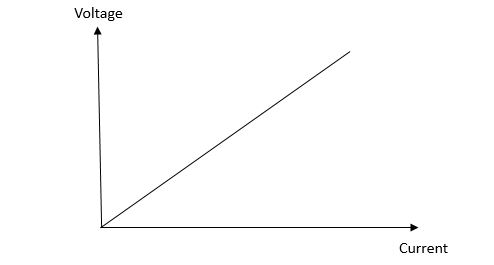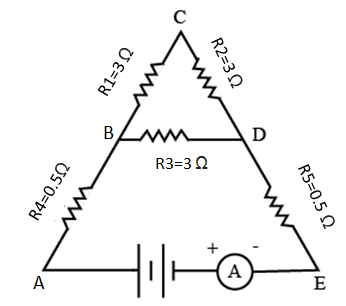10th Grade > Physics
ELECTRICITY MCQs
Total Questions : 244
| Page 2 of 25 pages
Answer: Option B. -> 1000 J
:
B
We know that, Power=Energytime, the SI unit of power is watt, energy is joule and time is second.
So, 1 W = 1 joule per sec and 1 kW = 1000 joule per sec.
Therefore, 1000 Jelectrical energy flows through the wire in 1 second when the power is 1 kW.
:
B
We know that, Power=Energytime, the SI unit of power is watt, energy is joule and time is second.
So, 1 W = 1 joule per sec and 1 kW = 1000 joule per sec.
Therefore, 1000 Jelectrical energy flows through the wire in 1 second when the power is 1 kW.
Answer: Option A. -> True
:
A
According to Ohm's law:
V=I×R; this means if R (resistance) is constant, current increases linearly as the voltage is increased.
At a constant temperature, following is the graph between voltage and current stated asOhm's law.

From the above graph, we can say that thecurrent varieslinearly with potential difference.
:
A
According to Ohm's law:
V=I×R; this means if R (resistance) is constant, current increases linearly as the voltage is increased.
At a constant temperature, following is the graph between voltage and current stated asOhm's law.
From the above graph, we can say that thecurrent varieslinearly with potential difference.
Answer: Option A. -> soft iron
:
A
The soft iron inside the coil makes the magnetic field stronger because it becomes a magnet itself when current is flowing through the coil.
Moreover, it loses its magnetism as soon as the current stops flowing. It forms a temporary magnet.In this way, the electromagnet can be magnetised and demagnetised by turning the electricity on and off.
:
A
The soft iron inside the coil makes the magnetic field stronger because it becomes a magnet itself when current is flowing through the coil.
Moreover, it loses its magnetism as soon as the current stops flowing. It forms a temporary magnet.In this way, the electromagnet can be magnetised and demagnetised by turning the electricity on and off.
Answer: Option A. -> increases
:
A
With the increase in temperature, the random motion of electrons increases. As a result, the number of collisions of electrons with the positive ions increases in a metal. Hence, the resistance of a metal increases with increase in temperature.
:
A
With the increase in temperature, the random motion of electrons increases. As a result, the number of collisions of electrons with the positive ions increases in a metal. Hence, the resistance of a metal increases with increase in temperature.
Answer: Option A. -> 1 A
:
A
Given,
Resistance values,
R1=R2=R3=3Ω
R4=R5=0.5Ω
Here the resistances R1 and R2 are in series. Let the equivalent resistance of this combination be R12.
R12=R1+R2
R12=3+3=6Ω
NowR12 and R3 are in parallel.
Let the equivalent resistance of thiscombination be R123.
⟹1R123=1R12+1R3
1R123=16+13
R123=2Ω
Now, R4,R123 and R5 are in series.
Let the equivalent resistance of this combination be R.
⟹R=R4+R123+R5
R=0.5+2+0.5Ω
R=3Ω
Using Ohms law,
I=VR
I=3V3Ω=1A
:
A
Given,
Resistance values,
R1=R2=R3=3Ω
R4=R5=0.5Ω
Here the resistances R1 and R2 are in series. Let the equivalent resistance of this combination be R12.
R12=R1+R2
R12=3+3=6Ω
NowR12 and R3 are in parallel.
Let the equivalent resistance of thiscombination be R123.
⟹1R123=1R12+1R3
1R123=16+13
R123=2Ω
Now, R4,R123 and R5 are in series.
Let the equivalent resistance of this combination be R.
⟹R=R4+R123+R5
R=0.5+2+0.5Ω
R=3Ω
Using Ohms law,
I=VR
I=3V3Ω=1A
Answer: Option A. -> 110 seconds
:
A
Current (I) is the rate of flow of charge (q) through a cross section per unit time (t).
I=qt
Given: q=10C, I=100A
t=qI
t=10C100A
t=110s
:
A
Current (I) is the rate of flow of charge (q) through a cross section per unit time (t).
I=qt
Given: q=10C, I=100A
t=qI
t=10C100A
t=110s
Answer: Option D. -> 10.25%
:
D
Resistance, R=ρLA
where:
ρ: Resistivity,
L: Length of the wire
A: Cross-sectional area of the wire.
The length of the copper wire is increased by 5%.
So, new length is:
L′=L+5100L=1.05L
Let the new cross-sectional area be A′.
On stretching the wire, its volume will remainconstant.
⟹LA=L′A′
A′=A1.05
New resistance will become:
R′=ρL′A′
R′=ρ(1.05LA/1.05)
R′=1.052R=1.1025R
Percentage increase in its resistance is,
p=R′−RR×100
p=(1.1025−1)RR×100
p=10.25%
:
D
Resistance, R=ρLA
where:
ρ: Resistivity,
L: Length of the wire
A: Cross-sectional area of the wire.
The length of the copper wire is increased by 5%.
So, new length is:
L′=L+5100L=1.05L
Let the new cross-sectional area be A′.
On stretching the wire, its volume will remainconstant.
⟹LA=L′A′
A′=A1.05
New resistance will become:
R′=ρL′A′
R′=ρ(1.05LA/1.05)
R′=1.052R=1.1025R
Percentage increase in its resistance is,
p=R′−RR×100
p=(1.1025−1)RR×100
p=10.25%
Answer: Option D. -> 25 W
:
D
Power consumed by the electric bulb, P=V2R, where V is the potential difference and R is the electrical resistance.
Given for 1st case:
Voltage V1=220V
and power consumed by bulb P1=100W,
In the 2nd case:
Voltage of the bulb, V2=110V
Power consumed by the bulb = P2
Since the resistance is the same as it is the same bulb
P1P2=(V1)2(V2)2
100P2=(220)2(110)2
P2=100×(110)2(220)2=25W
Power consumed when the bulb is operated at 110V = 25W
:
D
Power consumed by the electric bulb, P=V2R, where V is the potential difference and R is the electrical resistance.
Given for 1st case:
Voltage V1=220V
and power consumed by bulb P1=100W,
In the 2nd case:
Voltage of the bulb, V2=110V
Power consumed by the bulb = P2
Since the resistance is the same as it is the same bulb
P1P2=(V1)2(V2)2
100P2=(220)2(110)2
P2=100×(110)2(220)2=25W
Power consumed when the bulb is operated at 110V = 25W
Answer: Option A. -> electrons
:
A
Electric current is defined as the amount of charge flowing through a cross-section area per unit time. It's direction is conventionally taken opposite to the direction of flow of electrons.
:
A
Electric current is defined as the amount of charge flowing through a cross-section area per unit time. It's direction is conventionally taken opposite to the direction of flow of electrons.
Answer: Option D. -> less than
:
D
When resistors are connected in parallel,the equivalent resistance is less than the lowest resistance in the circuit.
Proof is as follows:
As we knowwhen R1,R2,R3...Rn resistors are connected inparallel circuit, the equivalent resistance of the circuit is
1Req=1R1+1R2...1Rn
1Req≥1Ri∀i∈{1,2,3,....,n}
⟹Req≤Ri
:
D
When resistors are connected in parallel,the equivalent resistance is less than the lowest resistance in the circuit.
Proof is as follows:
As we knowwhen R1,R2,R3...Rn resistors are connected inparallel circuit, the equivalent resistance of the circuit is
1Req=1R1+1R2...1Rn
1Req≥1Ri∀i∈{1,2,3,....,n}
⟹Req≤Ri

















